
 Prof Willem Boshoff, Department of Plant Sciences, University
Prof Willem Boshoff, Department of Plant Sciences, University of the Free State
 Amy Coetzer, Department of Plant Sciences, University
Amy Coetzer, Department of Plant Sciences, University of the Free State
Rust diseases are one of the major wheat production constraints. There are three types of rusts infecting wheat in South Africa, namely stem rust, caused by the fungus Puccinia graminis f. sp. tritici, leaf rust (P. triticina) and stripe rust (P. striiformis f. sp. tritici) (Photo 1).
Their distribution and importance in the different production areas are largely dependent on weather conditions and cultivar responses. Stem and leaf rust development is favoured by warmer temperatures, whereas stripe rust is historically known to occur under cooler weather conditions (night temperatures <15 °C and day temperatures <25 °C). Consequently, stripe rust is more important earlier in the season when cool moist conditions prevail.
The recent low incidence of stripe rust in South Africa can be attributed to genetic control with most of the recommended cultivars considered resistant. Rust pathogens can cause extensive yield and quality losses when left uncontrolled on susceptible cultivars by damaging the leaves and stems of wheat plants. Control measures are therefore necessary to minimise their negative impacts on wheat production.
Resistant cultivars provide effective control to the rusts. However, deployed resistance genes are often challenged with the emergence of new rust races which may affect cultivar response. New rust races can develop from local rust populations through genetic mutation, or they can occur in a specific area through exotic introduction from other regions or countries. Rust monitoring is essential for timely detection and determining the impact of new races as an early warning to prevent potential epidemics and damage to the wheat industry. Furthermore, rust monitoring assists in the identification of effective resistance genes which can be used in breeding and has been an important component of local wheat-breeding programmes. Researchers at ARC-Small Grain have been conducting annual rust monitoring (surveys) over the past 40 years. Through these surveys, many new rust races have been detected and used to advise producers on cultivar responses and to identify and characterise resistance sources for use in breeding.
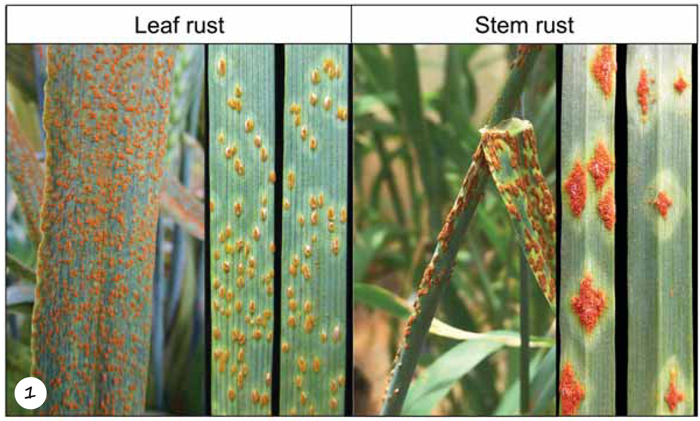
This article reports on the detection of a new stripe rust race in South Africa through surveys conducted during the 2022 season which covered the major wheat-growing areas. Samples of wheat leaves infected with stripe rust were collected from rust trap nurseries and commercial wheat fields. Spores collected from these samples were inoculated onto wheat seedlings of standard differential lines, each with known sources of resistance, and stripe rust races were identified based on their virulence pattern on these lines.
Stripe rust was detected in four of six trap nurseries (Bultfontein, Clarens, Ficksburg and Kransfontein) and from wheat in breeders’ experimental plots planted near Bethlehem. Infections in most of the trap entries were low (<5% severity). Furthermore, <5% severity of stripe rust was detected on most trap nursery entries planted at Tygerhoek (Riviersonderend) in the Western Cape. However, the rest of the nine trap localities and more than 35 producers’ fields surveyed in the Western Cape did not show any symptoms of stripe rust. Also, there was no stripe rust in the traps or producers’ fields visited near Bergville and Winterton in KwaZulu-Natal.
Samples collected and analysed from the above localities indicated the presence of race 6E22A+ at Bethlehem, Bultfontein, Clarens and Kransfontein; 6E22A- at Riviersonderend and Bloemfontein, and 6E16A- at Kransfontein, Napier, Albertinia and Riviersonderend. Isolates of these races were previously reported in South Africa and are not expected to affect current cultivar responses.
Infected wheat samples obtained from the warmer irrigation areas, including Marble Hall, Burgersfort and Groblersdal (Limpopo), Middelburg (Mpumalanga), Brits (North West) and Bultfontein (Free State), revealed the presence of a new race coded as 30E142A+. Isolates of the new race differ from previously detected stripe rust races in South Africa with virulence to the resistance genes Yr3a, Yr4a, Yr9 and Yr27 (Photo 2). A stripe rust race with the same virulence profile was reported in Zimbabwe during 2018, followed by the absence of the disease in the country from 2019 to 2021. However, stripe rust re-emerged in Zimbabwe causing localised outbreaks during August 2022.
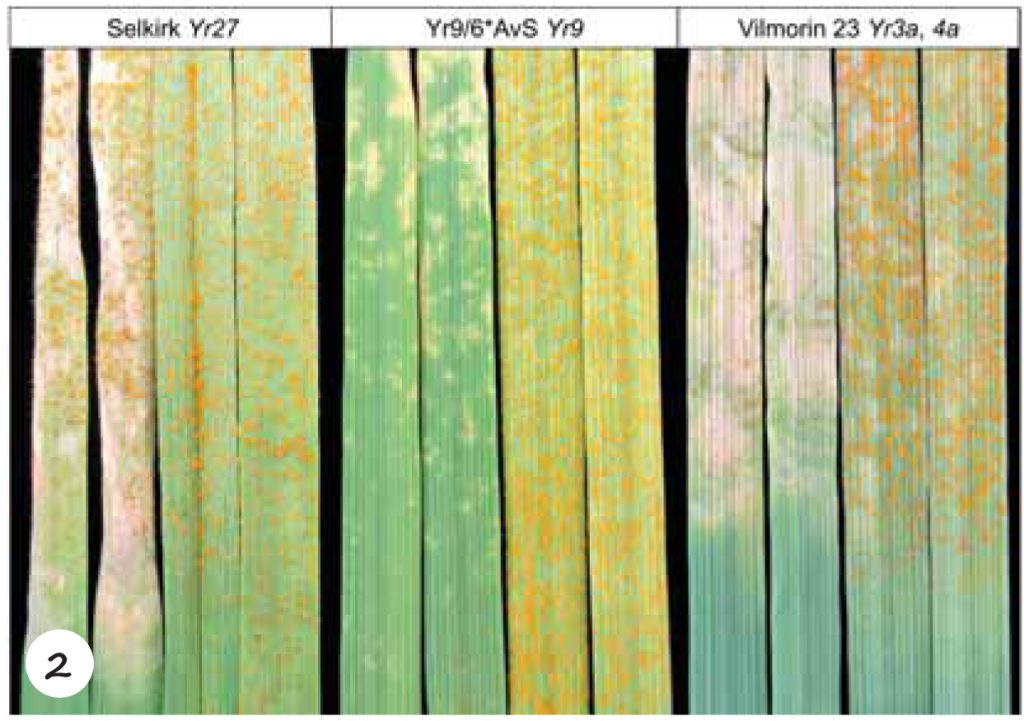
Race-typing data suggest that inoculum (spores) from Zimbabwe could be the source of the new stripe rust race detected locally during September 2022. Previous studies on the occurrence of leaf and stem rust races in Zimbabwe and South Africa indicated the possibility of rust inoculum exchange between the two countries.
The response of current commercial cultivars and breeding lines to the new race was evaluated under controlled conditions at the University of the Free State (UFS) to determine whether race 30E142A+ could pose a threat to local wheat production. Seedling infection data revealed that 41 out of 109 breeding lines and cultivars, resistant to the existing race 6E22A+, are susceptible to race 30E142A+, indicating the vulnerability of these entries to the new race (Photo 3). However, some of the cultivars that were found to be susceptible at the seedling stage may carry adult plant sources of stripe rust resistance (Photo 4). Adult plant evaluations were conducted on commercially available cultivars at the UFS (Photo 5, Table 1). The results indicated that several of the current cultivars show increased susceptibility to race 30E142A+ when compared to race 6E22A+. These findings are in support of observations made on cultivar responses in breeders’ plots as well as reports of localised outbreaks of the disease on previously resistant cultivars in the warmer irrigation areas during 2022.
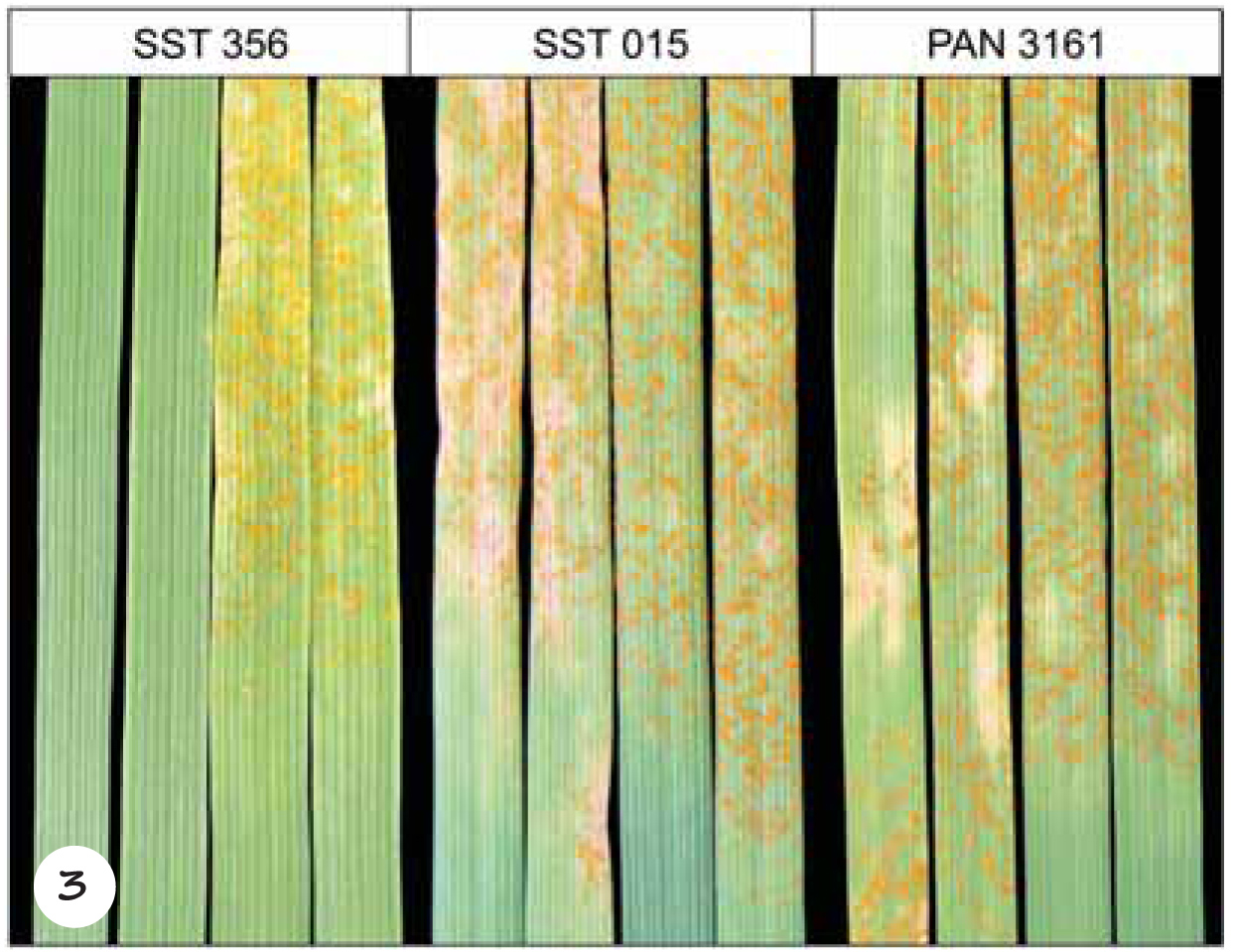
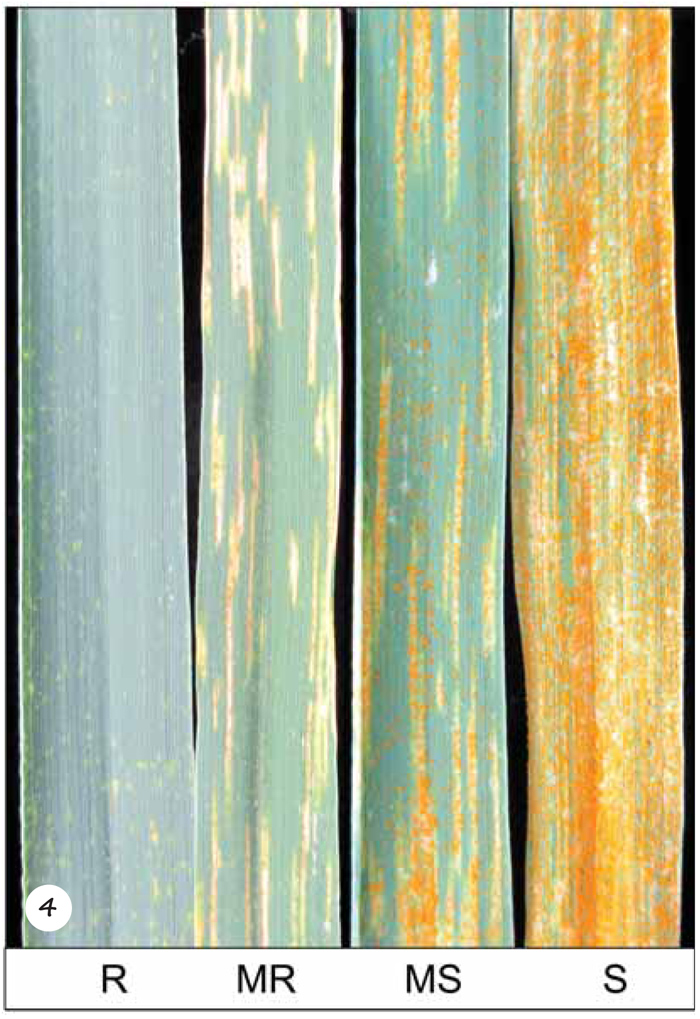
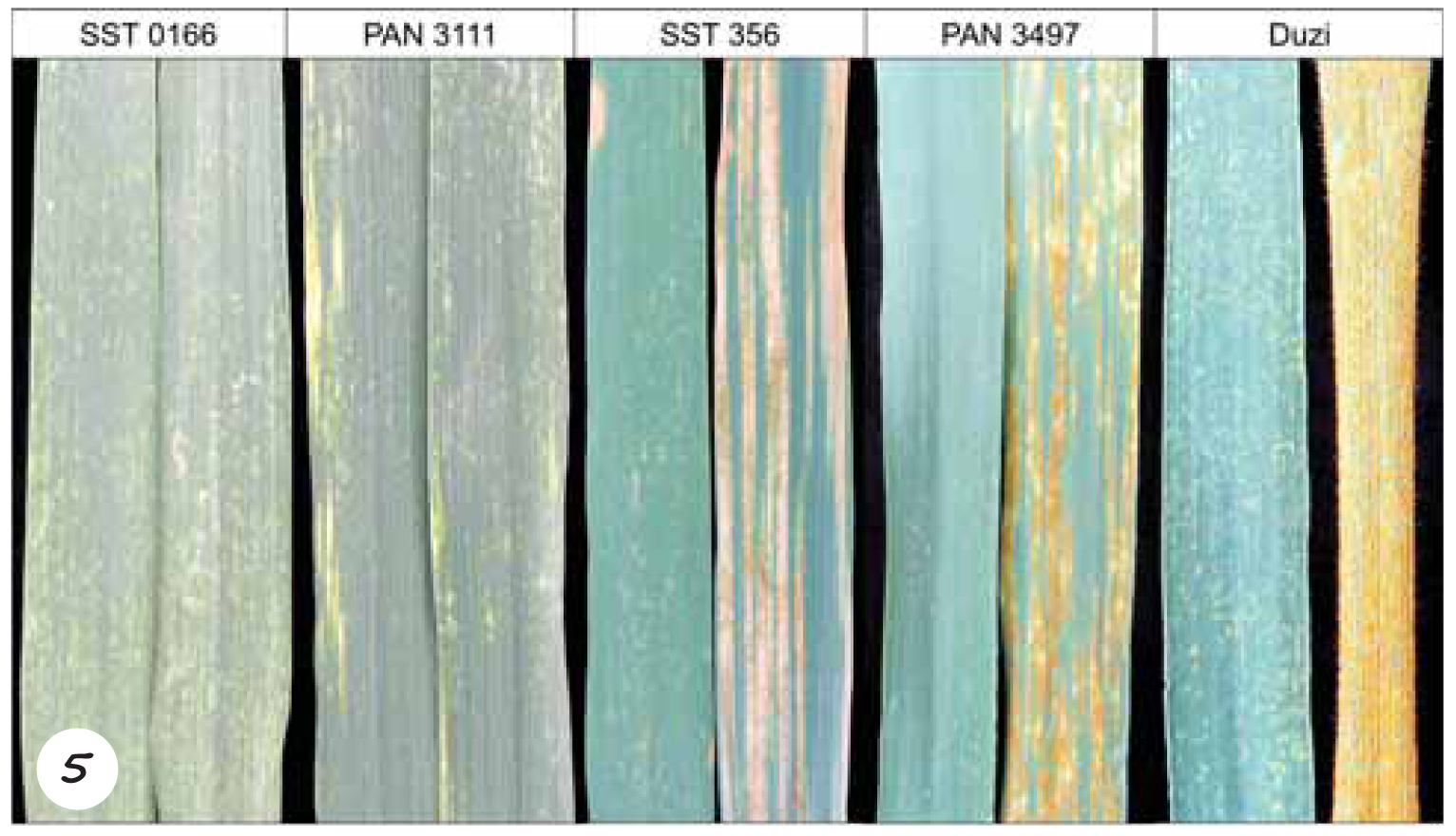
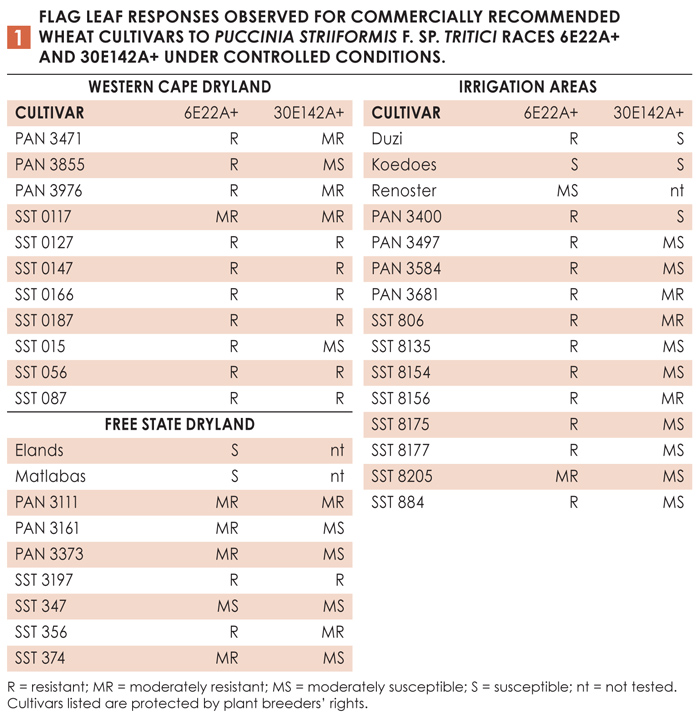 This detection of the new stripe rust race in South Africa is a cause for concern to wheat producers as it poses an increased risk of outbreaks during the 2023 season. More susceptible responses observed for a number of cultivars indicate that the potential of the new race to further spread and cause outbreaks during the 2023 season will largely depend on the presence of early season inoculum and favourable climatic conditions. It is also possible that the new race could be more adapted to warmer conditions, a phenomenon observed in many countries in recent years which requires further investigation. Self-sown (volunteer) wheat and susceptible grass plants (green bridges) can serve as hosts for the stripe rust pathogen during summer, becoming an important source of inoculum during the main season.
This detection of the new stripe rust race in South Africa is a cause for concern to wheat producers as it poses an increased risk of outbreaks during the 2023 season. More susceptible responses observed for a number of cultivars indicate that the potential of the new race to further spread and cause outbreaks during the 2023 season will largely depend on the presence of early season inoculum and favourable climatic conditions. It is also possible that the new race could be more adapted to warmer conditions, a phenomenon observed in many countries in recent years which requires further investigation. Self-sown (volunteer) wheat and susceptible grass plants (green bridges) can serve as hosts for the stripe rust pathogen during summer, becoming an important source of inoculum during the main season.
The wet summer season has favoured the growth of volunteer wheat and grasses and has created conducive conditions for infection and over-summering of the stripe rust pathogen. Susceptible wheat cultivars planted in wheat-growing areas characterised by cool and wet conditions (for example the eastern Free State, Western Cape and the cooler irrigation areas) could be at risk of infection with the new stripe rust race during 2023.
It is therefore important that wheat is regularly monitored during the growing season for signs of stripe rust infection. Infections observed on previously resistant cultivars suggest that the new race has probably caused the observed disease and the specific cultivar has lost its resistance. Under such circumstances, fungicide applications may be required to prevent disease spread and outbreaks. Samples of infected leaves from previously resistant cultivars can also be sent to ARC-Small Grain for race identification. The detection of a new stripe rust race in 2022 confirms the continued variability of wheat rusts in South Africa and stresses the significance of regular rust monitoring to timely identify and control new rust races.
Acknowledgements
The following instances and people are acknowledged: the South African Winter Cereal Industry Trust (SAWCIT) for funding this research, wheat breeders for supplying seed of their cultivars for rust assessment and for consent to make the data available, and Prof ZA Pretorius for proofreading and final edits to the article.
For reference and further reading visit https://www.ipp-projects.co.za/



























